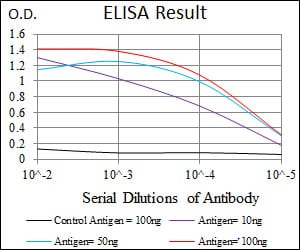
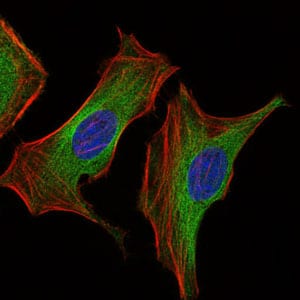
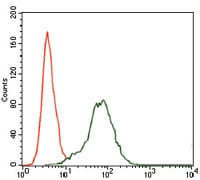
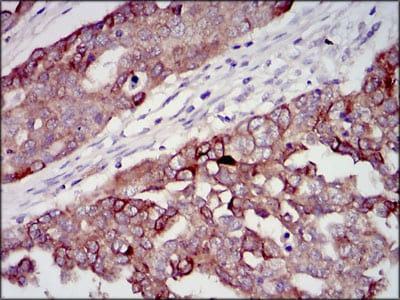
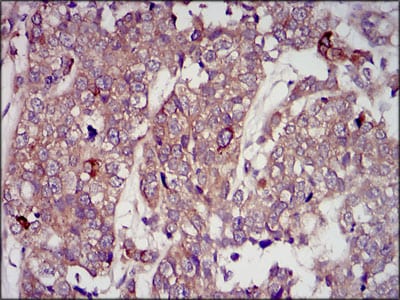
| WB | 咨询技术 | Human,Mouse,Rat |
| IF | 咨询技术 | Human,Mouse,Rat |
| IHC | 1/25-1/100 | Human,Mouse,Rat |
| ICC | 技术咨询 | Human,Mouse,Rat |
| FCM | 咨询技术 | Human,Mouse,Rat |
| Elisa | 1/2000-1/5000 | Human,Mouse,Rat |
| Aliases | IGF-II; PP9974; C11orf43; FLJ22066; FLJ44734 |
| Entrez GeneID | 3481 |
| clone | 8H1 |
| WB Predicted band size | 20.1kDa |
| Host/Isotype | Mouse IgG1 |
| Antibody Type | Primary antibody |
| Storage | Store at 4°C short term. Aliquot and store at -20°C long term. Avoid freeze/thaw cycles. |
| Species Reactivity | Human |
| Immunogen | Purified recombinant fragment of human IGF2 (AA: 25-180) expressed in E. Coli. |
| Formulation | Purified antibody in PBS with 0.05% sodium azide |
+ +
以下是3篇与EZR抗体相关的文献摘要信息,供参考:
---
1. **文献名称**:*Ezrin expression predicts survival in colorectal cancer*
**作者**:Kim CJ et al. (2012)
**摘要**:该研究通过免疫组化分析发现,Ezrin蛋白在结直肠癌组织中的高表达与患者不良预后显著相关。研究使用特异性EZR抗体验证其作为潜在生物标志物的价值,提示Ezrin可能通过促进肿瘤侵袭性发挥作用。
---
2. **文献名称**:*Role of Ezrin in pancreatic cancer progression and its interaction with HER2*
**作者**:Wang Y et al. (2015)
**摘要**:研究利用EZR抗体进行Western blot和免疫荧光实验,发现Ezrin在胰腺癌细胞中高表达,并与HER2受体协同激活下游MAPK信号通路,促进肿瘤转移。提示靶向Ezrin可能成为治疗策略。
---
3. **文献名称**:*Ezrin as a prognostic marker and therapeutic target in osteosarcoma*
**作者**:Salas S et al. (2010)
**摘要**:通过免疫组化和RNA干扰实验,该研究证实Ezrin在骨肉瘤细胞中高表达,且与肺转移风险增加相关。使用特异性EZR抗体验证其表达水平可辅助临床预后评估,并可能作为治疗靶点。
---
**备注**:以上文献信息为简化示例,实际引用时建议通过PubMed或Web of Science核对原文细节及最新研究进展。
EZR antibody targets Ezrin, a cytoskeletal protein encoded by the *EZR* gene and a key member of the Ezrin-Radixin-Moesin (ERM) family. These proteins act as crosslinkers between the plasma membrane and actin filaments, regulating cell shape, adhesion, motility, and signal transduction. Ezrin is particularly abundant in epithelial cells and microvilli, where it stabilizes membrane structures and facilitates interactions with extracellular environments. Its N-terminal domain binds to membrane proteins like CD44 or ICAMs, while the C-terminal domain interacts with actin, enabling dynamic cytoskeletal remodeling during processes like cell migration or polarization.
EZR antibodies are widely used in research to study Ezrin’s expression, localization, and functional roles. Dysregulation of Ezrin is linked to cancer progression, metastasis, and poor prognosis, as it enhances tumor cell invasiveness by promoting cytoskeletal reorganization. These antibodies are also employed in diagnosing and subtyping cancers, as Ezrin overexpression is observed in carcinomas, sarcomas, and gliomas. Additionally, EZR antibodies aid in studying immune responses, as Ezrin participates in T-cell activation and immunological synapse formation.
Common applications include Western blotting, immunohistochemistry (IHC), and immunofluorescence (IF). Researchers validate EZR antibodies using knockout cell lines or tissues to ensure specificity. Understanding Ezrin’s mechanisms through these tools provides insights into therapeutic strategies targeting cytoskeletal dynamics in cancer and inflammatory diseases.
×